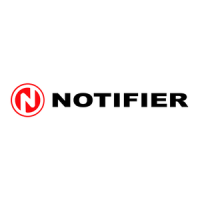
Do you have a question about the Notifier AUTOPULSE IQ-318 and is the answer not in the manual?
| Brand | Notifier |
|---|---|
| Model | AUTOPULSE IQ-318 |
| Category | Control Systems |
| Language | English |
Outlines limitations of life safety systems and potential failure points.
Procedures for re-acceptance testing after system modifications.
Includes FCC Warning and Canadian Requirements for the system.
Information on obtaining the latest software versions for the system.
Instructions for providing comments and suggestions for manual improvements.
Lists NFPA, UL, ULC standards and other relevant documents for compliance.
Details compliance with UL 864 9th Edition for control units and accessories.
Explains the meaning of CAUTION and WARNING statements used in the manual.
Introduces the IQ-318/E control panel, its features, and capabilities.
Details the standard equipment, options, and limitations of the IQ-318/E system.
Explains the functions and capabilities of the integrated power supply.
Illustrates the location of connections, switches, and LEDs on the circuit board.
Provides external measurements and mounting details for the system cabinet.
Lists electronic equipment compatible with the IQ-318/E, including UL 9th Edition status.
Guidelines for location, unpacking, checks, and relevant industry standards for installation.
A step-by-step checklist for installing, wiring, and testing the IQ-318/E system.
Instructions for securely mounting the system's backbox to a wall.
Guide for installing additional option boards within the IQ-318 cabinet.
Connects the panel to AC power and verifies its application.
Installs batteries and details external DC power output connections.
Instructions for connecting Notification Appliance Circuits (NACs) and releasing circuits.
Describes the Form-C relay connections for Alarm, Trouble, Supervisory, and Security.
Explains how to use backup-alarm switches for NACs during microcontroller failure.
Requirements for separating and routing power-limited and non-power-limited wiring.
Guidance on labeling non-power-limited circuits and modules for proper identification.
Instructions for connecting devices using the EIA-485 interface.
Steps for fabricating and connecting cables for printers and CRT terminals.
Information on connecting and configuring the PRN series printer.
Steps for connecting and configuring the CRT-2 display unit.
Guidance on connecting multiple printers or CRT displays to the system.
Details on wiring the SLC for intelligent and addressable devices, including capacity and styles.
Instructions for connecting a PC to the panel for programming using VeriFire Tools.
Introduces application types and devices requiring external power supervision.
Covers setup for NFPA 72 Central/Remote and Proprietary fire alarm systems.
Details combined fire/security and agent releasing system applications.
Programming type codes for control panel releasing outputs and FCM-1 modules.
References to wiring diagrams for connecting releasing devices.
Wiring instructions for connecting releasing devices to NAC terminals.
Wiring instructions for connecting releasing devices to the FCM-1 module.
Typical connections for wiring a releasing device to the FCM-1-REL module.
Typical connections for an NBG-12LRA Agent Release-Abort Station.
Requirements for conducting a complete operational test after installation.
Guidelines for regular testing and servicing of the control panel and devices.
Monthly checks to ensure proper system operation between formal tests.
Procedures for checking and maintaining system batteries, including safety warnings.
Method for calculating the required AC branch circuit current for the system.
How to calculate primary and secondary power source current draws for standby and alarm.
Calculates the maximum current draw from secondary power during fire alarms.
Steps to determine the required battery capacity based on system current draws.
Guide for choosing appropriate battery size and backbox based on calculated requirements.
Details specifications for AC power, wiring, and battery chargers.
Provides specs for SLC, NACs, releasing circuits, and relays.
Specifies wire types, gauges, and distances for various system circuits.